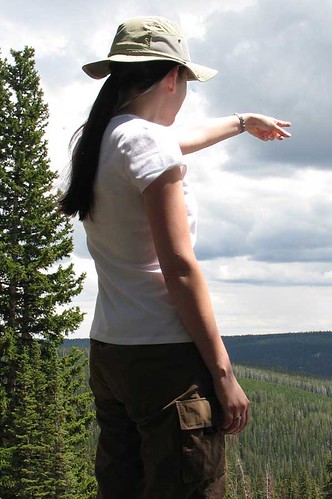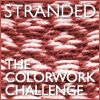Unraveling the truth
I've always wondered about the great divide between knitters and crocheters. Crocheters accuse knitters of being snobbish, and knitters claim crocheters are cheap. Really though, aren't we all on the same side? Don't we all love yarn?
One anti-crochet statistic I've seen thrown around quite a bit is that crocheting consumes three times as much yarn as knitting. Three times! I've even seen this claim made in print. (I'm referring to you, Yarn Harlot...with the utmost admiration and respect, of course. See page 118 of this fine book.) The implication—whether intentional or not—is twofold: (1) Crocheters waste yarn; and (2) Because of excessive yarn usage, crocheters can only afford to use cheap yarns.
Here's the thing: I don't believe it for a second. As a long-time crocheter and newbie knitter, I believe with every fiber of my being that crocheting does not use three times as much yarn as knitting. Yes, I'm willing to concede that, in general, crocheting does use more yarn than knitting. My guess would be on the order of one-third more, but certainly not three times more. I believe it, but I don't know it. Here at T4S HQ, we like to keep things scientific, so I'd say it's time for a little experiment.
Introduction
Knitting and crocheting are two methods of forming fabric by interlocking loops of yarn. Knitting forms the loops using two straight needles, and crocheting forms the loops using a single hook. Crocheted fabric tends to be thicker and sturdier than knitted fabric, leading to the assumption that it contains more yarn than the same area of knitted fabric. The purpose of this experiment is to compare the amounts of yarn used in different knitted and crocheted fabrics.
Materials and Methods
Five 10 cm square swatches were constructed from acrylic worsted weight yarn. (The research team determined it was not necessary to sacrifice wool yarn for the sake of this experiment. However, several cries of "It burns! It burns us!" were overheard during swatch construction.) Each swatch was constructed using the methods as follows:

- single crochet
- double crochet
- knitted stockinette stitch
- knitted garter stitch
- plain tunisian crochet
6.00 mm metal crochet hooks and 6.00 mm metal knitting needles were used to construct the samples.
Finished samples had the beginning and ending yarn ends cut to a length of 2 cm. Each sample was weighed on a digital kitchen scale. Because the kitchen scale is accurate only to whole grams, the research team determined that the length of the yarn used also needed to be measured. The samples were then unraveled, and the length of the yarn was wound around a rectangle of cardboard and measured using a tape measure.
Results
(The research team apologizes for the list format. Blogger would not properly render the research team's perfectly well-formed HTML table.)
- single crochet: 7 grams, 12.33 meters
- double crochet: 6 grams, 10.92 meters
- knitted stockinette: 4 grams, 9.10 meters
- knitted garter: 7 grams, 12.32 meters
- tunisian crochet: 7 grams, 13.10 meters
Discussion
Knitted stockinette stitch clearly used the least amount of yarn out of all the samples tested. Interestingly, tunisian crochet, that strange love child of crochet and knitting, uses the most yarn. Single crochet and knitted garter stitch use roughly the same amount of yarn. Double crochet uses more yarn than knitted stockinette stitch, but less than either single crochet or knitted garter stitch.
In any case, no method of crochet tested in this sampling uses three times as much yarn as either knitted sample. Single crochet uses slightly more than one-third more yarn than knitted stockinette stitch. It should be noted that the research team found that the crocheted samples had a more pleasing feel when crocheted using 6.50 mm hooks. The single crochet swatch constructed using a 6.50 mm hook had exactly one-third more yarn in it than the knitted stockinette swatch made with 6.00 mm needles.
Disclaimer: All results are subject to human error. The research team crochets a bit more tightly than it knits.
Do you think Mythbusters will hire me now?






30 Comments:
This makes me laugh, so scientific. I am currently working on a garter st sweater and I am always amazed at how heavy it is, compared to one knit in st st. This one is going to the Dulaan Project, so heavy is good.
Happy New Year!
Now that is way cool! As a long-time knitter and newbie crocheter, I'm delighted that you have exploded this pernicious myth. :-)
Darn, that's interesting. I've been trying to get crochet to click with me, and this post has me interested again.
Awesome post! :) (I love your pomatomus socks, too!)
Very well done! I am definately set straight :-)
I am going to have to link this to my blog.
Loveyou
MarlyKnits
www.knitthing.blogspot.com
Thanks for allowing me to post this on Yarnival!
Great post! But I think you have to actually blow something up (or at least start a fire) to get hired by the Mythbusters. :o)
I love this! So interesting! Thanks for doing all the scientific research and busting the myth!
Oh, and another thing -- I love knowing that garter stitch uses up so much more yarn than stockinette -- that's very good to know if one is short on yarn!
I love that you busted that myth. I've always thought that 3x more was a bit excessive but I never tried to test it out. Crochet isn't my main love, but it does make for beautiful edgings and felts faster and better than stockinette. At least it does using the dryer method in my house.
I would love to work for Mythbusters. My all-time favourite show.
I love this - very interesting research!
what a great idea to make such a geeky/science project out of it :) I love it.
As a old bag who has been doing both for years (crafty-bidextrous) I knew that crocheted used a litte more yarn. But certain projects would not look as nice or finished in knit and visa versa. Each has its place in the world of fiber. I believe your choice of fiber and color is the most important thing.
Pure genius! I've always wondered about this. :)
Micki,
Your results show that traditional crochet stitch use the same amount of less or less than the knit stitch (your garter swatch). (You missed that somehow.) The sc crochet fabric used 1/100th of a yard more than the knit swatch. That is probably due to tension or measurement error and is insignificant.
The stockinette swatch isn't an appropriate comparison since you are controlling for one stitch throughout each swatch. Stockinette uses two stitches.
You did an excellent job at showing that traditional crochet uses the same amount of yarn (sometimes less) than knitting! I just wish you had interpreted your results accurately.
I discuss your results on my blog at http://ayarnifiedlife.blogspot.com/2008/07/crochet-uses-less-yarn-than-knitting.html as well as on Ravelry.
I am not a fan of Yarn Harlot, so I have NO problem debunking what she says. THREE TIMES the amt. of yarn? I dont think so. :)
I use about 1/3rd more yarn crocheting than knitting. I think thats a pretty fair estimate. But its just another reason that LYS's shoud be courting crocheters...we buy more yarn :D
Wish I'd read this before tearing out my 2 ft of crochetted blanket using up old yarn. 2 ft into the knitting I re-weighed it, still don't have enough.
Have you done anything for different size needles, same stitches? E.g. Same 30 st swatch, different needles, measure with ruler.
Just the type of info I was looking for. I asked the question on Ravelry and was directed to your link.
I think I'll do a crochet feather and fan instead of a knit throw. I'm willing to 'sacrifice' the extra yarn -- and I knew it wasn't 3 times as much ....
Rosem
This was fantastic! I've yet to teach myself how to knit, but I'm sure I'll need it in the future. One of those fun facts all yarn obsessed people should know, too. =)
loved how scientific it is. Reminds me so much of those Chem lab reports I used to write up during the wee hours of the morning... haha
Obviously your testers are not well versed in Tunisian Crochet. To get the best results and to decrease the curl you should use a hook that is 1-3 times larger than recommended. You still get a sturdy fabric AND your because the stitches are larger, you use less yarn.
This may have been a good test, but it is far from being scientific.
Hmm..the poster above me sounds just a bit crabby...
Anyway, thank you for sharing the results of your project! So interesting, and your account of your research process is very witty - a rare but greatly appreciated quality in scientific publications ;)
I have always suspected that garter used more yarn than stockinette. Nice to have some data to look at.
Terrific experiment! I've always wanted to try that. I have always heard 30% more yarn. I'm a lover of both and find each one perfect for something!
This really made my morning! We crocheters are another step closer to "validating" ourselves to those nay-sayers. Now I'm inspired to crochet something right now. Hugs!
Apparently, some readers missed that when using the word 'scientific,' your tongue was firmly in cheek.
For most of us, this simple experiment provides enough information for us to make good choices for our projects.
For example, I had it in my head that Tunisian consumed the least amount of yarn, but always seemed to need more that I expected for a project.
Thank your for taking the time to run this 'scientific' experiment for those of us who are too lazy or who don't knit.
Absolutely love your sense of humor.
Really nice to have that tested out and set out so clearly :) definitely myth buster. I have another question though, why is it said that the crochet sample will be thicker, less drape than knit?
Thank you. This was very helpful and exactly what I was looking for. :D
Thanks for this post (even if it's more than a few years old.) I'm looking to "convert" a knit pattern to crochet, and thought I was going to need a thirds more yarn (that's the story I always heard), but looking at your chart, I don't think I'll need to, as the knitted pattern is garter stitch, and I'll be doing it in single crochet.
Wow! Absolutely excellent!
The perfect information, exactly what I was looking for and so informative! Thank you so very much :)
Plus I love how you include "Yarn Hoarder" in your personal profile summary...hehe...aren't we all?
If Mythbusters ever do a segment on yarn-related things, I do hope they give you a call...you deserve it!
How thick were the various test fabrics? This might be a consideration for warmth or bulk. Could you post the weight results?
Love this! Thank you for doing this as you did, there’s so many variables but you did a simple comparison, as another commenter said saying the word ‘scientific’ With your tongue in your cheek.
Great work, wish this was more widely publicised- it’s now 2025 and general opinion is that ‘Crochet uses twice as much yarn as knitting’ – Better than three times as much, but still incorrect😁
Look forward to sharing your information with others.
Post a Comment
<< Home